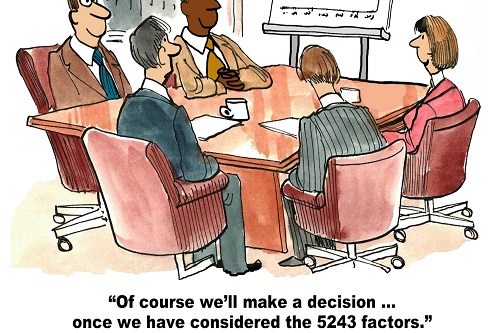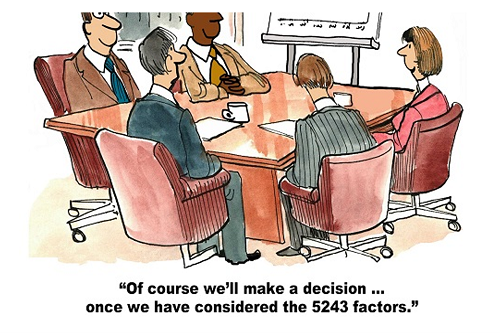Analysis paralysis occurs when a deluge of information, options, or other critical factors leaves an individual or organization unable to decide on a course of action. If not remedied, analysis paralysis can result in disastrous consequences. And unfortunately, it’s way too common a scenario in today’s data-driven world with the gargantuan amount of information available.
Toys R Us was once considered a goliath in its industry after its founding in 1948 by Charles Lazarus. It had an international presence and dominated the toy industry. But its preeminence ended with the giant retailer filing bankruptcy in 2018, closing its doors forever. While the reasons are many, one of the main causes was that the company was simply too slow to react to changes in the environment it found iteself in. The data was there, but it was either ignored, or management did not know what to do with it.
As a result of its inaction, Toys R Us lost momentum because it failed to keep up with technology and innovation. A multitude of bad business dealings and actions including a partnership with Amazon that ended in a lawsuit and the loss of millions of dollars potential revenue from sales during the lawsuit, only compounded the company’s internal issues and the organization collapsed.
Governments can also suffer from analysis paralysis. If we examine the rollout of COVID-19 vaccines during the pandemic, we find the distribution of vaccines slowed down, worldwide, because of the time spent in discussion and analysis of potentially rare side effects. Even though many countries had already approved and distributed the vaccines, others were caught in indecision.
Another area where we see this phenomenon is in the area of “Climate Change.” This problem demands attention and action from governments and organizations around the world. The amount of data was mountainous and being provided by a large number of sources, when combined, resulted in adding to the complexity of the issue. This, in turn, resulted in many governments being hesitant to commit one way or the other due to the uncertain outcomes of different approaches.
Typically, we see four main causes of analysis paralysis:
1. Fear of failure
People often fear doing the wrong thing or making the wrong decision and suffering the potential consequences of such an action. This generally leads to a state of inaction in which no decision is made.
2. Overthinking
Sometimes, people and organizations get stuck in a cycle of too much analysis. They look at too many scenarios and try to consider every possible outcome rather than focusing on a worse-case, best-case, and most likely case. Typically, we see two types of overthinking: the first focuses on rehashing past events and the second hyper-focuses on an anxiety-producing future concern.
3. Too many options
With the deluge of available data on anything and everything, there’s just too much information. Vast amounts of data raise questions about the data’s validity and reliability.
4. Lack of confidence
Some people and organizations just find it difficult to make a decision. They tend to “sit on the fence” and don’t want to commit for one reason or another.
 Image Source: Thinking – May 2022
Image Source: Thinking – May 2022
The Balanced Scorecard (BSC) Framework provides practical strategies you can use to overcome analysis paralysis and support sound business decisions and actions.
1. Set clear objectives
The BSC encourages the development of clear objectives, simply defined to help ensure that everyone understands the goal. This clarity helps to narrow down options and make the decision-making process more manageable.
2. Limit the options
The BSC focuses on three or four broad organizational goals based on specific objectives. This laser focus enables organizations to focus on what’s really important. The BSC uses specific filters in many of its processes to determine priorities and focus on the most achievable goals.
3. Break it down
The BSC breaks down the organization’s mission and vision into manageable elements that are easily understood and translated into an actionable strategy.
4. Establish a timeframe
The BSC encourages organizations not to drag out the process and to complete it in 8 to 12 weeks or less. It promotes using agile processes to keep activities, initiatives, and reporting on track and current.
5. Seek advice
The Balanced Scorecard Institute (BSI) experts don’t just teach you the theory: we teach you how to implement and manage it. We’re always available to our clients to provide you with our 20+ years of expertise in strategy development and execution.
We all know that analysis paralysis can be an extremely frustrating challenge, but it’s not insurmountable. Ultimately, taking action and making a decision based on specific strategies and initiatives is the most important step. While weighing options and making informed decisions is crucial, over-analyzing or delaying action due to bureaucratic red tape or other circumstances can lead to missed business opportunities and other negative consequences.
If your business is struggling with analysis paralysis, we can help. Connect with us via email or call us at 919-460-8180.
Terry is Balanced Scorecard Institute's Director of Training and Senior Associate with over 30 years of experience working in both the private and public sectors.


